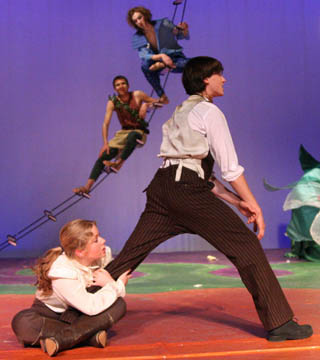MV Drama’s adaptation of William Shakespeare’s “A Midsummer Night’s Dream” begins with a classic love triangle as Hermia (senior Emily Williams) is being forced to marry Demetrius (junior Jarryd Alfaro) despite her love for the charming Lysander (sophomore Tomer Assaf). The Duke of Athens (senior Alex Sakhanyuk) tells Hermia that she will either be put in a convent or executed should she refuse Demetrius’s advances. Regardless, Hermia and Lysander steal away from Athens, planning to flee to Lysander’s aunt. The plot thickens when Hermia’s friend and Demetrius’ spurned ex-lover Helena (senior Jeanette Deustch) tells Demetrius of his bride-to-be’s escape in an effort to regain his love. All the lovers, along with a bumbling band of aspiring thespians, end up in an enchanted forest inhabited by fairies—throw an Eastern theme into the mix, and otherworldly chaos ensues. 
Despite a somewhat lackadaisically performed exposition, due in part to Sakhanyuk’s poor articulation and muffled projection, “Midsummer” truly enchanted the audience once its protagonists arrived at the magical forest.
By far the most absorbing character portrayed, the mystical fairy king Oberon (senior Nick Erickson) was bright and well-received. But where would any fairy king be without his subservient sprite? Puck (senior Joseph Payne) kept the audience laughing with his antics and enchantments. And the character of Nick Bottom (senior Alex Moresco) was a complete ass… literally! Moresco not only played out Bottom’s dramatic and pompous personality, but managed to bring it out loud and clear—with a few “hee-haw”s thrown in for good measure—all in donkey-head!
Physical comedies can often fall flat, but this one was brilliantly executed. In one particular scene, Deutsch puts forth a great performance as Helena finds herself fighting for her unrequited love, Demetrius. The poor girl was left with a boot and a broken heart, while Demetrius was left screaming for a restraining order—all in the spirit of comedy, of course.
The forest, brought to life by glittering fairies and ethereal fabrics, was quite possibly the crowning glory of the play, alongside the fairies’ gossamer costumes. The intricacy of the costumes, designed primarily by senior Christine Yu, was most apparent in the fairies’ individual looks. Also impressive was the fairies’ makeup and body decorations, allowing them to bring an air of effervescent mystique to the play. The ubiquitous presence of the fairies in the forest seemed a part of the set itself, and they were used almost as props, scattered all over the stage to add to the atmosphere of the enchanted forest.
Besides the set, the mix of Arabic and classical Indian influences, namely in the music and architecture, was the major mood-setter in the play. Though the music and architecture were generally an inaccurate, Westernized hodgepodge of Eastern cultures (which director and Drama teacher Holly Cornelison acknowledges in the Director’s Notes), they served to create a sense of intrigue.
True to The Bard’s word, “Midsummer” proves to be quite the dreamy work of art. Who needs reality anyway when you’ve got a fantasy world full magic and dramatic irony?






